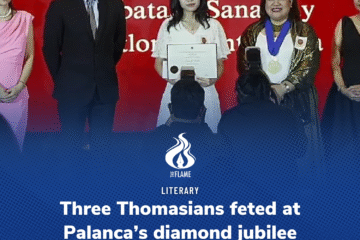by HJADOEYA V. CALICA

THE SENTIMENTAL value of life depends on what is seen in the curious eyes of the beholder. To fit human experiences into a category, whether grand or minute, would limit its capability to mimic life.
A manifestation of these experiences is Life in a Flash: Stories.
The UST Publishing House launched the collection of stories last June 22, 2023. Under the mentorship of UST Center for Creative Writing and Literary Studies Director Cristina Pantoja-Hidalgo, 16 authors contributed 97 works to the book, including the nine works of the editor, Rhona Lopa-Macasaet.
All stories highlighted and impersonated life with a limited yet exact amount of words needed. From these brief yet perceptive tales, life is revealed in a flash, coinciding with the book’s title.
The book established the flash in fiction by the swift pace of the stories revolving in a single setting and incorporating the total number of words at the end of every piece. With the stories ranging from 100 to 1,000 words, romanticization was described by the stories in the anthology—may it be pain or satisfaction.
Descriptive romanticization
Life in a Flash: Stories foretold that human experiences are not mere memories to let pass.
Ranging from childhood, infidelity, and encounters with a stranger, to queer love stories, these themes are united by romanticizing life in the eyes of the narrator—by being sentimental and treasuring every bit of their existence.
Despite the authors’ diverse writing styles, their narrating techniques became the common ground of their stories—written thoroughly with consideration of the writers’ aim to convey the character’s state. For example, Secret by Popi Laudico is about surreptitious meetings with someone, while Mañosa’s Tagu-Taguan presents the intriguing sexual conversation between the two children in the story.
The objective to impress the readers that the anthology consists of stories with familiar core memories is visible in the first entries. Jak ‘n’ Poy by Gem Deveras Mañosa took a regular Filipino game into something gruesome. Meanwhile, Smell of Skin by Popi Laudico narrates a sad yet intimate story of a lesbian couple.
Each story uses the five human senses: sight, sound, touch, taste, and smell. These senses are stretched to create one piece, usually only focused on one sense. Missed Connections [After Craiglist] by Macasaet applied the sense of physical and emotional feeling when the narrator yearns for the departing stranger. The instant connection between the two strangers is described.
Similar to Antidote by Quintin Jose Pastrana, the sense of sight was applied to glorify the sea and the memories attached to it. It was the epitome of the recurring theme of romanticizing life. Both stories use suffering and delusions to look at the brighter side of their life.
Macasaet and Pastrana’s pieces were flash fiction, yet they felt like a novel because the pieces were written with keen detail and lengthened intricacies.
The flaw of the ideal life
Since the stories lean on the side of the ideal life, some of the events and themes were glorified, including extrajudicial killings, post-war trauma, and abuse. Memory by Maridol S. Mabanta and Matthew 5:38-40 by Macasaet presented these limited subjects as themes.
Among the vast collection of stories, the absence of digesting pain as pain, not something that makes life beautiful, is disappointing. Considering that the Philippines has long been glorifying resiliency since the post-colonial period, it subtly conforms to the traditional values of pain as a challenge in life.
The title is both an advantage and a setback—the stories are indeed presenting life, yet, it was a take into a more comfortable scene. It was written based on a privileged view.
What the anthology offers in terms of new concepts in life is within limits; most of them are only a replication of the usual stories and experiences in life. But what it offers in the literary scene is immense—Life in a Flash: Stories challenges how narrative and descriptive writers write fictional stories, especially flash fiction.
What separates the collection from others are the stories written outside the traditional form, such as Pastrana’s Woke: A Love Story in Ambahan, by incorporating a poem in the fiction that is vital for the storyline, and Laudico’s Alchemy which is written in a numeric form to reveal the sequence of events of how two people met.
These stories, however, are underlined with too many figurative language devices, which resulted in vague endings that rely only on the assumption of perception from the readers.
The collection’s sophisticated themes make the readers appreciate the simple things in life. Although not exceptional from other collections, Life in a Flash: Stories depicts the bliss of life in different stages and experiences, introducing the idea of life anew. F



